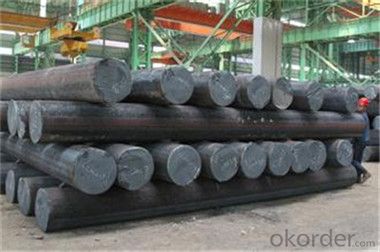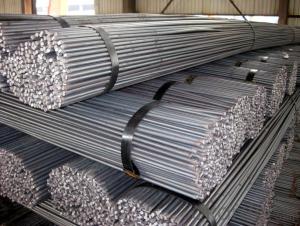C45 / SAE1045 / 45# Forged Steel Round Bars
- Loading Port:
- Dalian
- Payment Terms:
- TT OR LC
- Min Order Qty:
- 200 m.t.
- Supply Capability:
- 20003332 m.t./month
OKorder Service Pledge
OKorder Financial Service
You Might Also Like
Description of steel round bar:
1. Commodity: Round steel bar
3. Technical: Hot rolling
2. Length: Min. 5.8meter, according to requirement.
3. Diameter: 16mm-250mm
Festures of steel round bar:
Main products | |
Hot work tool steel | |
DIN | 1.2344,1.2343,1.2365,1.2581,1.2367,1.2714 etc. |
AISI | H13,H11,H10,H21,L6 etc. |
JIS | SKD61,SKD6,SKD5,SKT4 etc. |
Cold work too steel | |
DIN | 1.2601,1.2379,1.2080,1.2363,1.2842,1.2419,1.2510,1.2550,1.2767 etc. |
AISI | D2,D3,A2,O2,O1 etc. |
JIS | SKD1,SKD11,STD12,SKS31,SKS3 etc. |
Plastic mould steel | |
DIN | 1.2083,1.2311,1.2312,1.2316,1.2738 etc. |
AISI | P20, P20+Ni,P20+S,420 etc. |
JIS | NAK80 |
High speed tool steel | |
DIN | 1.3355,1.3343 |
AISI | T1,M2 |
JIS | SKH2,SKH51 |
Structural alloy steel | |
DIN | 1.7225,1.6511 |
AISI | 4140,4340 |
JIS | SCM440 |
We also supply customized special steel, contact us for more information ! | |
Specifications of steel round bar:
20CrMnTiH series, 20CrH-20CrH, 20CrMoH-42CrMoH, CrMnMoH series, CrNiMoH series, 20CrNi3H, MnBH series, SCr415H-SCr440H, SCM415H-SCM440H, 8620H-8627H, 4120H-4145H, 4320H,4340H, 5137H, 15Ni4Mo, 15CrNi6, 16CrNi4, 19CrNi5, 17CrNiMo6, 34CrNiMo6, 25CrMo4, 42CrMo4, 49CrMo4, 30CrMoV9, 16MnCr5,20MnCr5, 28MnCr5, 16CrMnBH, 17CrMnBH, 18CrMnBH, etc.
Images of steel round bar:

FAQ:
1. What is your package?
Packing situation: standard seaworthy packing or as customer required.
2. How long is the lead time?
Delivery time: 45 days after order confirmed.
3. What payment term do you accept?
Payment: T/T or L/C at sight.
- Q:Can steel round bars be used in the construction of bridges?
- Yes, steel round bars can be used in the construction of bridges. They provide structural strength, durability, and flexibility, making them suitable for various components such as piers, beams, and reinforcements. The high tensile strength of steel round bars allows for the construction of longer and larger bridges, ensuring stability and safety. Additionally, steel is resistant to corrosion, which is crucial in bridge construction due to exposure to environmental elements.
- Q:Can steel round bars be used for making medical equipment?
- Yes, steel round bars can be used for making medical equipment. Steel is a strong and durable material that can be easily shaped into various forms, including round bars. These round bars can be further processed and machined to create different components or structures required in medical equipment such as surgical instruments, implantable devices, and hospital furniture. Additionally, steel is also known for its corrosion resistance, making it suitable for applications in the medical field.
- Q:Can steel round bars be bent or formed into different shapes?
- Yes, steel round bars can be bent or formed into different shapes. Steel is a highly malleable material, which means it can be easily shaped without breaking or cracking. To bend or form steel round bars, various methods can be used, such as heating the bars to make them more pliable or using specialized tools like hydraulic benders or presses. The degree to which steel round bars can be bent or formed depends on factors such as the thickness and composition of the steel, as well as the specific shape or angle desired. Overall, steel round bars offer a versatile option for creating a wide range of shapes and structures in various industries, including construction, automotive, and manufacturing.
- Q:What are the different alloying elements used in steel round bars?
- Steel round bars can be produced using various alloying elements that enhance their properties such as strength, durability, and specific characteristics. Some commonly utilized alloying elements in steel round bars include the following: 1. Carbon: Primarily used, carbon increases the hardness and strength of steel round bars, typically ranging from 0.2% to 2.1% carbon content. 2. Chromium: Added to improve corrosion and oxidation resistance, chromium also enhances hardness, strength, and wear resistance. Stainless steel round bars often contain significant amounts of chromium. 3. Nickel: Commonly found in stainless steel round bars, nickel improves corrosion resistance and mechanical properties, making the steel tougher and stronger. 4. Manganese: Added to enhance hardenability, strength, and wear resistance, manganese also contributes to the steel's ability to withstand impact and shock loading. 5. Molybdenum: Often used to enhance strength, toughness, and corrosion resistance, molybdenum also improves high-temperature strength and creep resistance. 6. Vanadium: Added to improve strength, toughness, and wear resistance, vanadium refines the steel's grain structure, enhancing its mechanical properties. 7. Tungsten: Utilized to increase hardness, strength, and resistance to wear and corrosion, tungsten also improves high-temperature strength and toughness. 8. Silicon: Added to improve strength, hardness, and resistance to oxidation, silicon aids in deoxidizing the steel during manufacturing. 9. Copper: Occasionally used, copper improves corrosion resistance, thermal conductivity, and electrical conductivity in steel. These alloying elements are just a few examples of those that can be used in steel round bars. The specific combination and proportion of these elements depend on the desired properties for the steel and the intended application of the round bars.
- Q:What are the different cutting methods used for steel round bars?
- There are several cutting methods commonly used for steel round bars, including abrasive cutting, cold saw cutting, band saw cutting, and plasma cutting. Each method has its own advantages and suitability depending on factors such as the required precision, speed, and cost-effectiveness of the cutting process.
- Q:What is the maximum diameter of a steel round bar?
- The maximum diameter of a steel round bar can vary depending on the specific grade and type of steel being used. However, in general, the maximum diameter of a steel round bar typically ranges from 1 inch to 12 inches. Larger diameters may be available on a custom order basis. It is important to consult the manufacturer or supplier for specific information regarding the maximum diameter of a steel round bar for a particular grade and type of steel.
- Q:Are steel round bars resistant to UV radiation?
- Typically, steel round bars lack resistance against UV radiation, which can induce oxidation and lead to rust formation. Consequently, the structural strength of the steel may weaken, potentially causing deterioration over time. However, safeguarding steel round bars from UV radiation is achievable by applying a protective layer like paint or a specialized coating. This layer acts as a barrier against harmful UV rays. Moreover, storing the bars in shaded areas or utilizing covers can effectively reduce their exposure to UV radiation, thus prolonging their lifespan.
- Q:Can steel round bars be used in the production of electrical equipment?
- Steel round bars are capable of being utilized in the production of electrical equipment. Steel possesses a multitude of properties that render it suitable for various applications, including electrical equipment. Components such as shafts, connectors, and structural supports within electrical equipment can be manufactured using steel round bars. The reliability of steel is derived from its strength and durability, enabling it to withstand the mechanical stresses and environmental conditions that electrical equipment may encounter. Moreover, steel offers favorable electrical conductivity and magnetic properties, crucial characteristics for specific electrical components. Nevertheless, it is important to acknowledge that steel round bars may necessitate additional processes like machining, heat treatment, or surface finishing in order to meet specific requirements for the production of electrical equipment.
- Q:How do you determine the appropriate steel grade for a specific application?
- To determine the appropriate steel grade for a specific application, it is necessary to have a comprehensive understanding of the application's requirements and the properties of different steel grades. The following steps should be considered: 1. Begin by clearly defining the specific requirements of the application, such as load-bearing capacity, corrosion resistance, temperature resistance, and durability. Take into account factors such as the environment the steel will be exposed to, the expected stress levels, and any specialized characteristics needed. 2. Research the various steel grades available in the market once the application requirements are understood. Identify steel grades known for possessing the desired properties required for the specific application. Consult industry standards, expert opinions, and available resources to gain insights into different steel grades and their performance in similar applications. 3. Analyze the physical, mechanical, and chemical properties of the steel grades under consideration. Evaluate key properties such as strength, ductility, toughness, hardness, corrosion resistance, weldability, and formability. Compare these properties with the application requirements to determine which steel grades align best with the specific needs. 4. Evaluate the cost and availability of the steel grades that meet the application requirements. Take into account factors such as the initial cost, maintenance costs, and availability of the steel grade in the required form and quantity. This step ensures that the chosen steel grade is not only suitable but also feasible from an economic perspective. 5. Seek advice from experts, such as metallurgists or engineers, to gain valuable insights into selecting the appropriate steel grade. Their expertise and experience can help weigh the pros and cons of different steel grades, identify potential challenges, and suggest alternatives or modifications if necessary. 6. If feasible, conduct testing or trials using samples of the selected steel grade to assess its performance under real-world conditions. This step can help validate the suitability of the chosen steel grade and identify any unforeseen issues or areas for improvement. By carefully considering the application requirements, researching steel grades, evaluating material properties, considering cost and availability, seeking expert advice, and conducting testing and trials, one can effectively determine the appropriate steel grade for a specific application.
- Q:The difference between 304 stainless steel round bar and bright round bar
- The difference between the stainless steel round bar and the bright round steel of the same material is that the bright circle is cold rolled (or cold drawn), and the black circle is hot rolledThe processing method is different
1. Manufacturer Overview |
|
|---|---|
| Location | |
| Year Established | |
| Annual Output Value | |
| Main Markets | |
| Company Certifications | |
2. Manufacturer Certificates |
|
|---|---|
| a) Certification Name | |
| Range | |
| Reference | |
| Validity Period | |
3. Manufacturer Capability |
|
|---|---|
| a)Trade Capacity | |
| Nearest Port | |
| Export Percentage | |
| No.of Employees in Trade Department | |
| Language Spoken: | |
| b)Factory Information | |
| Factory Size: | |
| No. of Production Lines | |
| Contract Manufacturing | |
| Product Price Range | |
Send your message to us
C45 / SAE1045 / 45# Forged Steel Round Bars
- Loading Port:
- Dalian
- Payment Terms:
- TT OR LC
- Min Order Qty:
- 200 m.t.
- Supply Capability:
- 20003332 m.t./month
OKorder Service Pledge
OKorder Financial Service
Similar products
New products
Hot products
Related keywords































